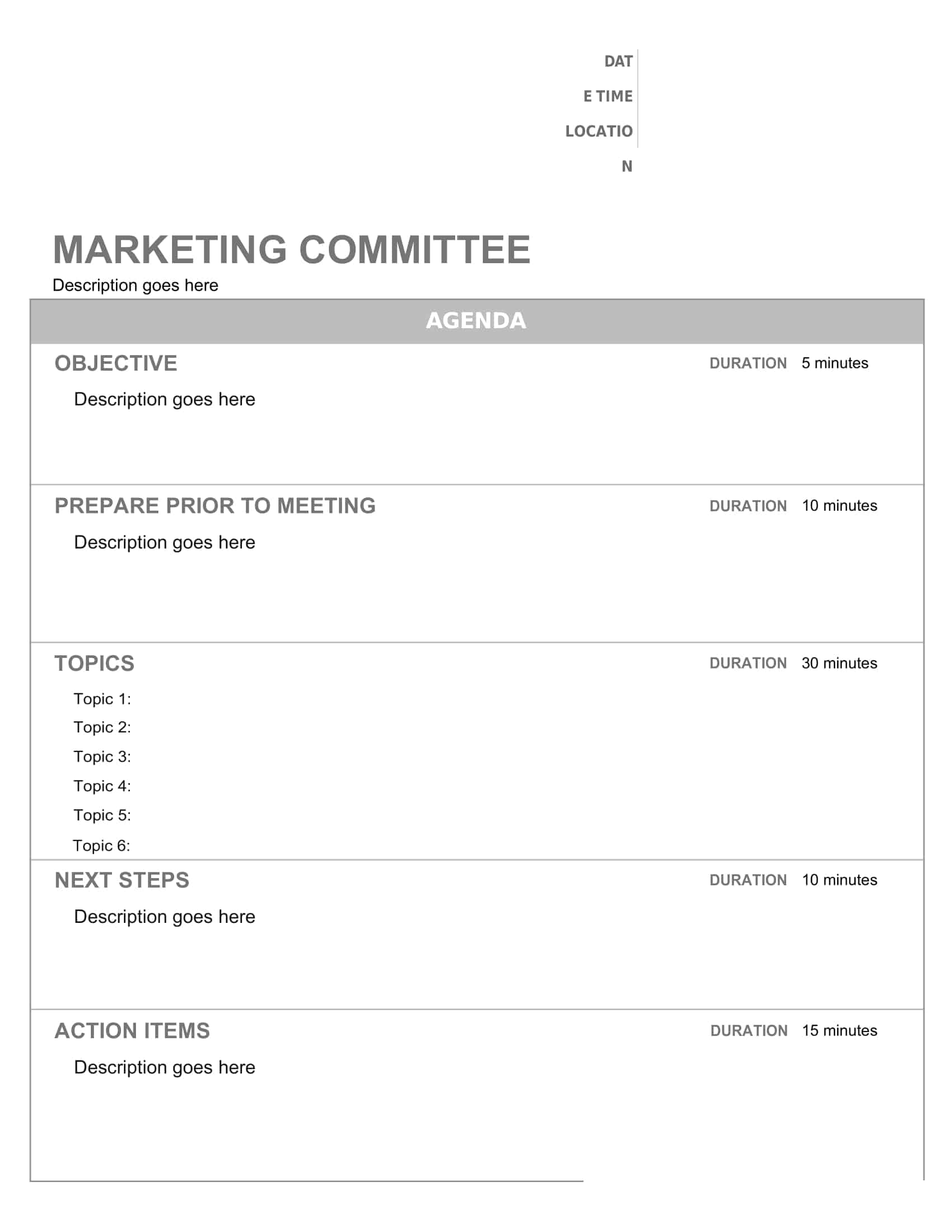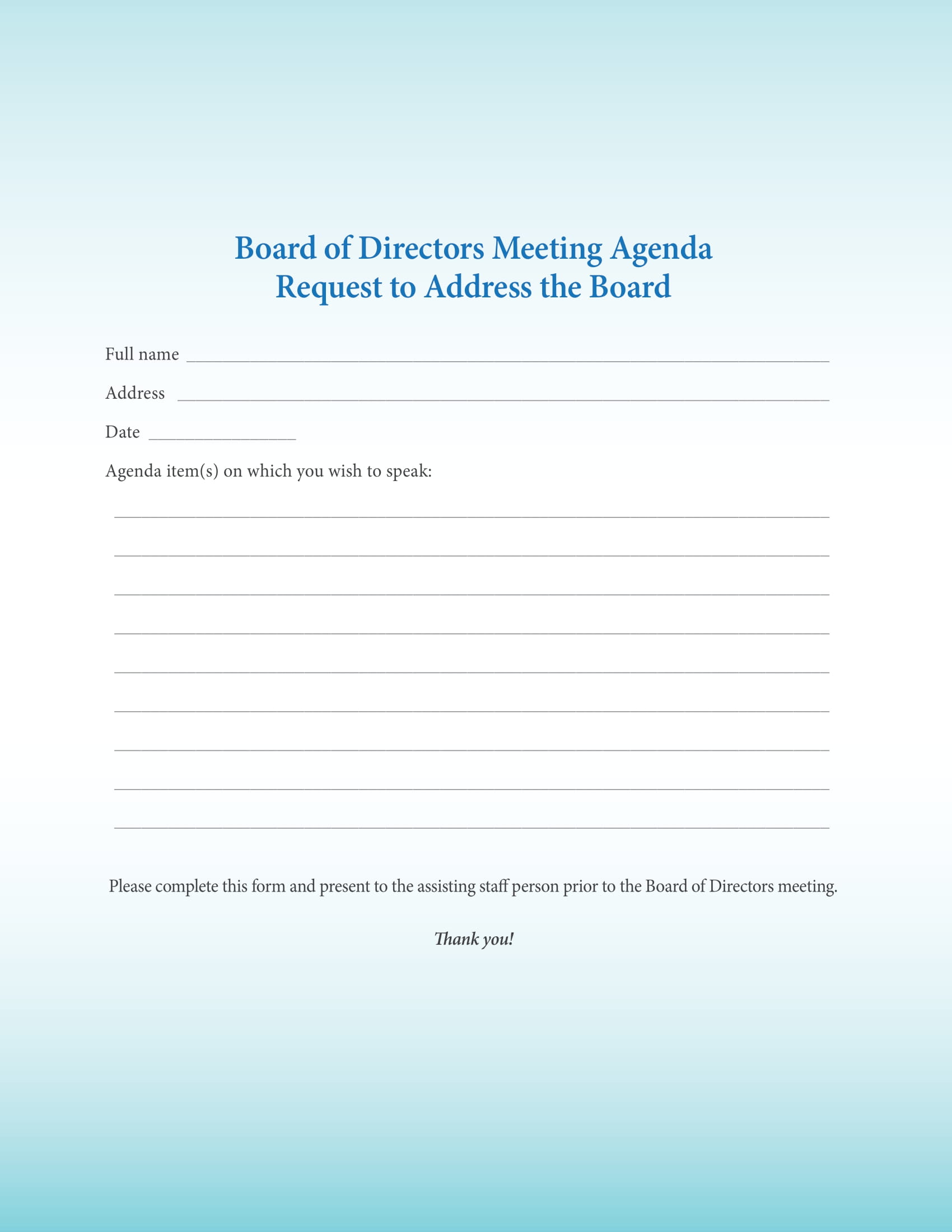It’s incredible how a little planning and structure can drastically improve your efficiency and productivity. Creating an agenda for a board meeting will help you focus the group on what needs to be discussed during the meeting and, more importantly, how much time should be spent discussing each item.
This will help you save time and increase productivity as the company moves forward with its objectives within the year. I recommend creating an easy-to-follow template for all your board meetings for some added structure. Almost by force of habit, using the same template each time allows you to stay focused on relevant and meaningful discussions to the company’s mission and goals.

The purpose of a board meeting agenda template is to provide an outline that includes the venue and date, the people involved, a sample agenda, and the topics for the meeting. Notice it doesn’t hurt to cover the sub-topics; however, starting with the main topic is more acceptable.
Table of Contents
Board Meeting Agenda Templates
Board meeting agenda templates are pre-designed documents that provide a structured format for organizing and conducting effective board meetings. These templates serve as a blueprint for creating agendas that ensure important topics are discussed, decisions are made, and actions are taken during board meetings.
Board meeting agenda templates typically include sections for the meeting date, time, and location, as well as a list of items to be discussed and addressed during the meeting. They may also include sections for reviewing previous meeting minutes, presenting reports, discussing specific topics, and allocating time for open discussions or presentations.
Using a board meeting agenda template helps streamline the meeting planning process and ensures that board members and attendees have a clear understanding of the meeting’s purpose and objectives. It allows for the prioritization of important agenda items and helps maintain focus and efficiency during the meeting.
Pre-meeting Preparation
The board meeting agenda is just a list of the topics to be decided on during this meeting. The secretary of a board prepares an agenda prior to each meeting and, in a sense, is a roadmap for the direction of the organization.
For businesses, education systems, universities, and government agencies, an agenda consists of specific items that are talked about during the regular course of business. While this sheet may be updated often, I believe due dates can still be heavily affected by the time it takes to organize and get information from those responsible for completing tasks.
While the board secretary prepares for the meeting, the president should contact the individuals that are scheduled to speak at the meeting and get their presentations ready. Both parties should be prepared so as not to waste everyone’s time with last-minute preparation. Usually, meetings take several hours.
Structure of a Board Meeting Agenda
When creating a board meeting agenda, there are several items that should be included. This doesn’t have to include all of the items listed below, but it should be thorough enough to ensure that you don’t leave anything out. As you are planning your next board meeting, keep these items in mind:
Heading
The agenda header must contain the name and address of the organization. Also, The Agenda should also include the date, time, and location of the meeting.
Call to Order
Typically, the first order of business in a board meeting is for the chair to announce that the meeting has been called to order and provide just the time. The secretary writes this information down in the minutes of the meeting. After that, the board chairman can begin with the start of the actual board meeting.
Changes in the Agenda
The 2nd and any subsequent items on the board of directors meeting agenda can be discussed. If there are any changes, the board of directors’ agenda can move forward. If there are no changes, the Agenda can move to approve next month’s meeting notes.
Approval of Minutes
This is the third item on the Agenda. The Agenda shows the issues handled at each meeting. It lists what was discussed, when and by whom, and it includes information that members need to know specifically for this meeting.
Reports
This is the fourth order of business on the Agenda. The report must come from the Executive Director and include a review of projects, operations, business outlook, including negative and positive trends and other important aspects.
Old Business
This part of the Agenda includes prior business matters that you have not resolved, that require a Board vote, or that require further discussion. You may present these issues or refer them to a committee for further discussion.
New Business
These are discussions about new business issues and action plans. The plan may include raising the problems, delaying action, or referring the issues to a committee.
Comments, Announcements, and Other Business
In this instance, on the Agenda of the board meeting, members can make announcements, e.g., B. Express congratulations or condolences or complete other special announcements. Any other matters can be raised at this point, for example, items that need to be added to the Agenda for the next meeting. The secretary should have copies of the minutes of the previous meeting for distribution. Finally, it is customary for the chairperson to provide information on current projects.
Adjournment
The board chairman concluded the meeting by announcing the end to the rest of the board members and passing over the future business to be proposed at the next meeting. All other pending business was also mentioned. The date of the next meeting was also announced, and all members were informed of this as well.
Board meeting notes should cover the following topics:
- who attended the meeting at what stage and how (by phone or directly),
- where and when the meeting was held and what main agenda items it included (it would also be helpful to note how much time was allocated to each item),
- the type of meeting and when and how it is announced (is it a predetermined regular meeting or an extraordinary meeting?; is it a meeting of the entire board of directors or a committee meeting?),
- whether there is an evaluation phase (executive session) where the managers are not present at the meeting,
- the opinions of the members about what information is presented to the participants and when, and whether the members find the information presented sufficient or not,
- which the board of directors considers alternatives and their dimensions and, if any, differences of opinion between them,
- the decisions are taken and their reasons,
- the opinions of the members who do not comply with the decision, if any,
- indications that members have made independent assessments and the status of members who exclude themselves from the decision process on issues that may potentially conflict of interest,
- indications that members decide with timely and adequate information.
You have to keep the accurate minutes of all your board meetings and enter these into a minute book. The minutes must show the decisions you have made and your discussions. As soon as you have agreed that this is accurate, you must let the chairman sign it as an official record of your meeting.
FAQs
How do you structure a board meeting agenda?
Effective board meeting agendas organize items logically into standard sections like: Call to order, Roll call/Establish quorum, Review agenda, Approve prior minutes, Committee reports, Unfinished business, New business proposals, Discussions, Public comment period if applicable, Executive session if needed, Summarize actions, Next mtg date/time, Adjourn.
Who prepares the agenda for a board meeting?
The board secretary often prepares a draft agenda in coordination with the board chair and organization leadership based on business needing covered for the next meeting timeframe. They compile submissions, sequence priority topics, finalize the agenda for distribution per advance notice policies and statutes.
What are the examples of meeting agenda?
Typical agenda examples are strategically sequencing meeting events: Begin with roll calls, consent agenda approvals for expedience, priority business and discussions when energy is fresh, followed by routine reports, public comments periods if required, executive sessions as needed for confidential topics, ending with summarizing actions and scheduling.
How do you write an agenda for a non profit board meeting?
When planning a non profit board meeting agenda: Lead with mission moments grounding intentions, sequence critical governance items first prioritizing strategy then oversight matters, integrate interactive educational activities raising knowledge, offer Q&A discussions on impact reports leaving room for organic discourse over packed, rigid scheduling.
What does a good board meeting look like?
Attributes of an engaging, productive board meeting include: Concise, focused agenda sent in advance, consistent structure yet responsive facilitation keeping interest, active discussions eliciting all voices, varied information delivery keeping energy up, clear decision wrap-ups and next step assignments, appreciations exchanged closing out positively.
How do you run a board meeting Robert’s Rules?
Follow Robert’s Rules guiding orderly deliberations by: Establishing quorum for valid votes, processing motions properly stated then seconded, limiting members’ speaking times equally through recognized floor grants ordered by the chair, focusing comments on-topic avoiding personality issues, summarizing decisions clearly documenting next actions assigned.








































![Free Printable Credit Card Authorization Form Templates [PDF, Word, Excel] 1 Credit Card Authorization Form](https://www.typecalendar.com/wp-content/uploads/2023/06/Credit-Card-Authorization-Form-150x150.jpg)
![Free Printable Stock Ledger Templates [Excel,PDF, Word] 2 Stock Ledger](https://www.typecalendar.com/wp-content/uploads/2023/08/Stock-Ledger-150x150.jpg)
![Free Printable Financial Projections Templates [Excel, PDF] 3 Financial Projection](https://www.typecalendar.com/wp-content/uploads/2023/05/Financial-Projection-1-150x150.jpg)
